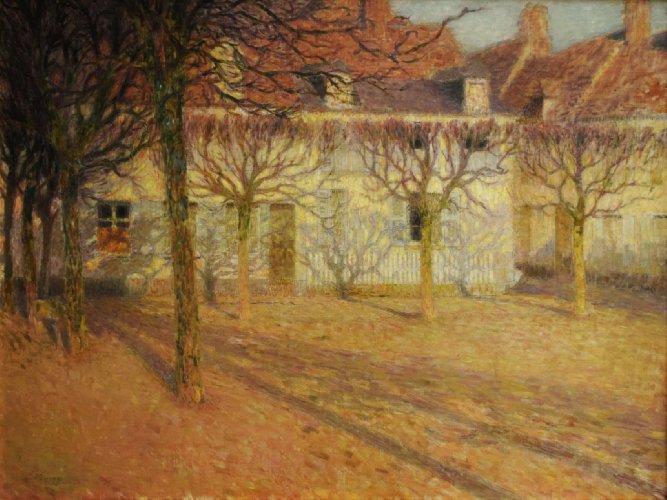Description:
Henri-Eugène-Augustin Le Sidaner (1862-1939) studied at the École des Beaux-Arts, but his passion for Monet and Manet quickly replaced his academic painting. He lived and worked in Etaples Boulogne and also in Bruges in Brussels, before finally moving to France. He exhibited at the Salon of the Société des Artistes Français and Société des Nationale des Beaux–Arts. In his deserted landscapes, he focused on the search for light, as well as the symbolism of the views presented
Description of the painting:
Leafless, evenly trimmed trees stand in a row like sentinels of a house. Their shadows form decorative patterns on the bright façade. The trees growing on the left, in a denser formation, create a dark, clustered mass of branches obscuring the roof of the house. The long shadows of unseen trunks cross the foreground, adding variety to an empty space. The deserted image exudes emptiness, as if the only inhabitants of the area were the trees. Low, sharp light reflects off some of the windows, but those to which the rays do not reach remain empty and dark.
Leafless, evenly trimmed trees stand in a row like sentinels of a house. Their shadows form decorative patterns on the bright façade. The trees growing on the left, in a denser formation, create a dark, clustered mass of branches obscuring the roof of the house. The long shadows of unseen trunks cross the foreground, adding variety to an empty space. The deserted image exudes emptiness, as if the only inhabitants of the area were the trees. Low, sharp light reflects off some of the windows, but those to which the rays do not reach remain empty and dark.
The composition is painted with pastel, softened colors. Le Sidaner perfectly observed the characteristic of a sharp, low–falling, winter sun which seems often slightly dulled, dispersed and cooler. The artist painted the picture in the neoimpressionist technique of Divisionism, which is through the arrangement of different color spots next to each other. Looking at the picture closely, clear spots that are not mixed with each other can be seen, and when viewed from a distance, a clearer view is formed, characterized by a slight blurring of contours and a wavy surface, as if the picture were living its own life.
Le Sidaner is difficult to unambiguously match to any particular art movement of the time. Whereas the Impressionists and Neo–Impressionists used very bright, even garish colours for their landscapes, focusing on the effects of light, Le Sidaner muted, blurred and dulled the light in his landscapes. He was not content with mere beauty, the representation of reality and observation of light, he sought to go deeper, to give his images symbolic meaning, to express feelings, emotions and moods through them.
The art of Rogalinski was greatly influenced by the works of Monet and Manet, as well as by Fritz Thaulow, with whom he went on a trip to the Netherlands in 1891, during which many paintings were created. Perhaps he adopted a certain melancholy of quiet, deserted and moody landscapes from him. Thaulow‘s paintings are also in the Rogalinski Gallery. In 1904, the artist bought a property in Gerberoy, where he focused particularly on the green area, trying to create a place competing with Monet‘s garden in Giverny.


